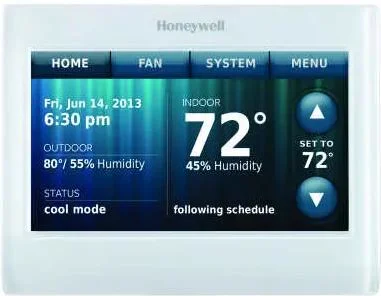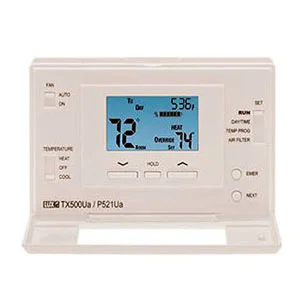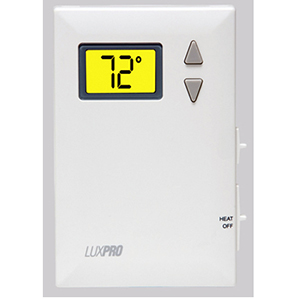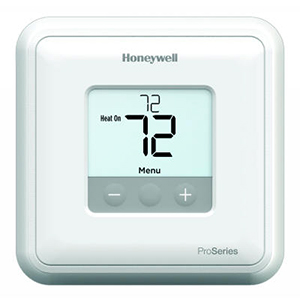Thermostats
Programmability
Programmable thermostats save energy, save you money and maximize comfort based on your unique schedule! They typically have four setpoints, allowing you to set different temperatures for the morning, daytime, evening and over night. Most programmable thermostats can operate in a non-programmable mode if you choose not to set a program. A non-programmable thermostat's settings must be manually changed for temperature and on/off functionality.
Application Type
Thermostats vary by the different types of heating and/or cooling units they control.
Heat Only - works only with a single heating source.
Cool Only - works only with a single cooling source.
Single Stage Heat/Cool - controls one heating source and one cooling source.
Multi-Stage Heat/Cool - controls multiple heating and cooling sources.
Electric Heat/Line Voltage - controls electric baseboard and electric heaters.
Heat Pump - used in heat pump applications, such as air source heat pumps and ground so.urce heat pumps.
Fan Coil - work with fan coil units, such as unit ventilators.
Millivolt - used to regulate systems that utilize a pilot light rather than an electrical circuit, such as a gas-fired water heater.
Stages
This refers to the number of heating or cooling sources that may be controlled by a single thermostat. For example, if a system contains baseboard heat, a hot air system and air conditioning, then there are two heating stages and one cooling stage. In this example, a 2 heat/1 cool thermostat should be installed. Note: If you have auxiliary heat (backup heat, such as a fan coil or baseboard), that counts as a second heating source. The number of stages may be written in several different ways. The most common are 2H/1C or 2 Heat/2 Cool; both mean that there are two heat sources and one cool source. The number of stages can vary from single heat or single cool up to 4 Heat/3 Cool on a single thermostat.
User Interface
Thermostats are operated using a digital touchscreen, buttons with a digital screen, or simple mechanical dial.
Voltage
Thermostats run on either line voltage or low voltage. The easiest way to tell if you need a line or low voltage thermostat is to look at the wire. If it's a very thin wire (like a doorbell or speaker wire), you'll need a low voltage thermostat. If it's a heavy wire, you'll need a line voltage thermostat.
Changeover Type
Thermostats either have automatic changeover or manual changeover. Thermostats with auto changeover switch from heat to cool automatically depending on the indoor temperature, while thermostats with manual changeover will remain on either heat or cool until you change it.
Overview
Honeywell's Wi-Fi 9000 allows remote access to the thermostat through a computer, tablet, or smart phone with Honeywell's Total Connect Comfort Service.
Features
Get Connected – Connect to home’s existing Wi-Fi network
Remote Control – Convenience, comfort and control from anywhere through web, tablet or smartphone access
Apps available for tablet and smartphones
Automatic software updates through Wi-Fi
Selectable to 7 Day or Non-Programmable
Program thermostat locally or over the web or app
Customize the screen color to match any décor
TH9320WF5003 is ENERGY STAR® Certified
Features:
- Separate Weekday and Weekend Programs (2 or 4 periods/day)
- Large Display with Back light
- Adjust Heating and Cooling Limits
- Keyboard Lock
- Programmable Air Filter Monitor
- Speed Slide™ for Easy Programming
- Selectable Smart Recovery
- Dual Power - 2 AA Batteries Included
- User Selectable Programmable or Non-Programmable Operation
- Manual Temperature Hold
- Temporary Temperature Override
- Adjustable Temp. Differential Cycle Rate
- Adjustable 2nd Heat Stage Offset Setting
- User Temperature Calibration
- 5/2 Minute Selectable Time Delay
- Battery Free Memory Storage
- 12/24 Hour Clock Display
- Optional Wall Plate Available
- 1.5 Amps per Terminal at 24 Volts
- Temperature Control 45F to 90F (7C to 32C)
- Terminals O, B, G, Y, RC, RH, W1, A, W2, C
Features
• Easy installation
• Program 7-day, 5/2-day, or non-programmable
• Easy-view back light
• Optional wall plate model #WP567
• User option: 2 or 4 periods per day
• Programmable keyboard lock
• Temporary override and manual hold
• Dual powered (2AA) Alkaline Batteries (included)
• Temporary Compressor protection bypass
• 5/2 minute selectable time delay for equipment protection
• User temperature calibration
• Display option: fahrenheit or celsius temperature
• Adjustable heating and cooling limits
• Air filter monitor
• Selectable smart recovery
• AM/PM clock or military time option
Features:
• Digital Heat Only
• Attractive Slim Design
• Large Illuminated Digital Display
• Adjustable Temperature Stops
• Soft Touch Buttons
• Battery Powered
• Electronic Accuracy
• Fan Switch and Terminal
• Fahrenheit/Celsius Switchable
• 5 Minute Compressor Protection
• Easy Installation
• Optional Wall Plate Available
Features:
• 1H/1C - Non-Programmable
• Electronic Accuracy
• Can be mounted horizontally or vertically
• Large, easy-to-read digital display
• EL (electro luminescent) backlight
• Temperature swing adjustment to as close as + or - 1/4o F/C
• Universal replacement ~ System or battey powered
• Low battery indicator ~ Optional decorative wall plate
• 5 or 2 minute compressor delay
• 5 0r minute minimum "on" time
• Fahrenheit or Celsius ~ Temperature offset (user calibration)
• "O" abd "B" terminals
Features:
• 2 Wire - Heat Only
• Clean attractive design
• Snap Action Mechanism
• Valued priced
• Adjustable heat anticipator
• 2-Wire Heat only mechanical thermostat
• Contains no Mercury
Features:
• Heat & Cool
• Clean attractive design
• Snap Action Mechanism
• Valued priced
• Adjustable heat anticipator
• Heating and cooling mechanical thermostat
• Contains no Mercury
Features:
A single pole, line voltage manual thermostat that offers ease of use. For heat only.
The LV11 is a single-pole heat only, manual thermostat that is easy to install and use. With a clean attractive design this unit is unobtrusive while providing features to enhance your system. As with the complete Lux thermostat line, this unit is mercury free.
• Contains No Mercury
• 5 Year Limited Warranty
• ETL Certified (USA, Canada)
• Dimensions are 2.75"W x 4.50"H x 1.50"D
• Setting Range 41F to 90F
• 1 Stage Heat Only
• Single Pole (2-Wires)
• 120/240 VAC Systems up to 22 Amps
Features:
Thermostats provide 24 Vac control of heating or cooling systems
Heat Only
Features:
1 Heat/1 Cool Conventional Systems and Heat Pumps with No Auxiliary Heat
Features:
The Round® thermostats provide electronic control of 24Vac heating and cooling systems with the classic twist to set dial.
Heat Only
Features:
The Round® thermostats provide electronic control of 24Vac heating and cooling systems with the classic twist to set dial.
1 Heat/1 Cool Conventional Systems and Heat Pumps with No Auxiliary Heat
Features:
The Digital Round® Thermostats provide 24V control of heating only or heat/cool systems.
T1 Pro non-Programmable thermostat for 24 Vac systems, single stage heat only or cool only systems.
24 Vac systems; Gas, Oil, Electric Warm Air; Hot water Coil; Gas, Oil, Electric Hydronic; or Steam / Gravity Systems
T4 Pro Programmable Thermostat with stages up to 1 Heat/1 Cool Heat Pumps or 1 Heat/1 Cool Conventional Systems
Replaces TH3110D1008 & TH4110D1007
Overview
The T Series programmable thermostat streamlines everything from product selection and installation to customer service and support. With a standard footprint and simple interface, the T Series will enhance the entire thermostat experience for you and your customers alike.
Features
TH4110U2005 1H/1C heat pump and 1H/1C conventional
7-day, 5-2, 5-1-1 or non-programmable
Uses the UWP mounting system that’s standard across all T Series thermostats
Easy upsell to a connected Lyric T6 Pro Wi-Fi when your customer is ready for Wi-Fi (C-wire required)
Simple push-button functionality
Filter change reminders
5-year warranty
T6 Pro Programmable Thermostat with stages up to 2 Heat/1 Cool Heat Pumps or 2 Heat/2 Cool Conventional Systems
Replaces TH6220D1028 & TH5220D1029
Overview
The T Series programmable thermostat streamlines everything from product selection and installation to customer service and support. With a standard footprint and simple interface, the T Series will enhance the entire thermostat experience for you and your customers alike.
Features
TH6320U Up to 3H/2C heat pump and 2H/2C conventional
TH6220U Up to 2H/1C heat pump and 2H/2C conventional
TH6210U Up to 2H/1C heat pump and 1H/1C conventional
7-day, 5-2, 5-1-1 or non-programmable
Uses the UWP mounting system that’s standard across all T Series thermostats
Easy upsell to a connected Lyric T6 Pro Wi-Fi when your customer is ready for Wi-Fi (C-wire required)
Optional dual fuel (TH6320U & TH6220U only)
Optional wired indoor/outdoor sensors (TH6320U & TH6220U only)
Simple push-button functionality
Filter change reminders
5-year warranty
Features:
VisionPRO® 8000 with RedLINK™ technology for residential or commercial use. Stages up to 3 Heat / 2 Cool
Replaces TH8320U1008/U
Universal programmable thermostat with 3 heat/2 cool stages
Heat/Cool or Heat Pump with Auxiliary Heat
Features:
Non-programmable heating and cooling digital thermostat
Up to 2 Heat/2 Cool Conventional Systems; Up to 2 Heat/1 Cool Heat Pumps



















Features:
• Spec Sheet
• 1 Stage Heat - 1 Stage Cool
• Easy to Reprogram Lux Speed Dial ®
• System or Battery Powered
• Large, Lighted LCD Display
• 5 Minute Run Time Delay
• Temporary Override ~ Vacation Override
• System Cycle Adjustment
• Battery Free Memory Storage
• Weekday/Weekend Programming
• 4 Periods Per Day Heating & Cooling
• Single Stage Heating & Cooling
• Electric Heat/Cool
• 24 Volt Millvolt
• Oil Heat ~ Gas Heat
• Single Stage Heat Pump
• Lighted Display
• Filter Monitor and Indicator